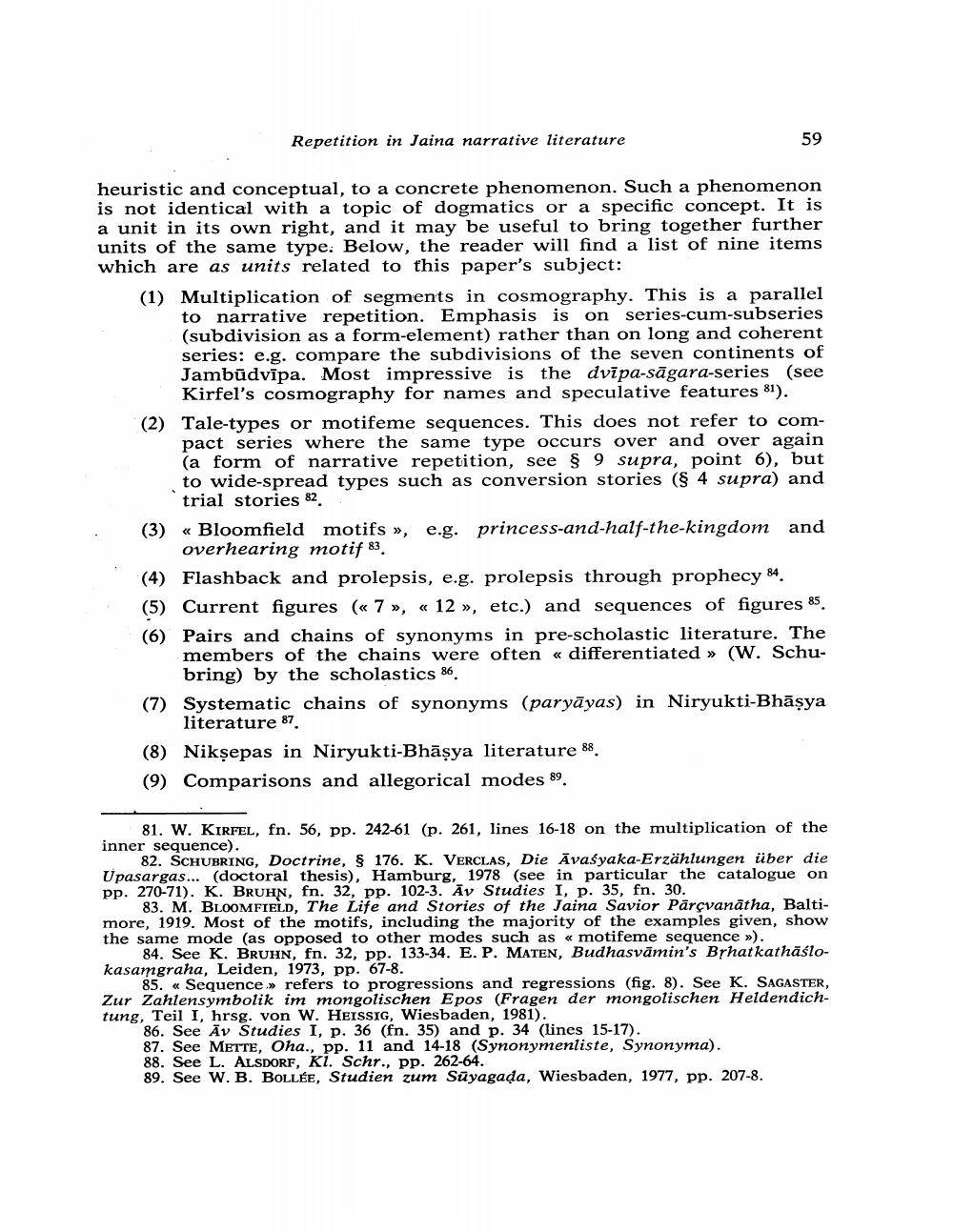________________
Repetition in Jaina narrative literature
59
heuristic and conceptual, to a concrete phenomenon. Such a phenomenon is not identical with a topic of dogmatics or a specific concept. It is a unit in its own right, and it may be useful to bring together further units of the same type. Below, the reader will find a list of nine items which are as units related to this paper's subject: (1) Multiplication of segments in cosmography. This is a parallel
to narrative repetition. Emphasis is on series-cum-subseries (subdivision as a form-element) rather than on long and coherent series: e.g. compare the subdivisions of the seven continents of Jambūdvīpa. Most impressive is the dvīpa-sāgara-series (see
Kirfel's cosmography for names and speculative features 81). (2) Tale-types or motifeme sequences. This does not refer to com
pact series where the same type occurs over and over again (a form of narrative repetition, see 9 supra, point 6), but to wide-spread types such as conversion stories (8 4 supra) and
trial stories 82 :) « Bloomfield motifs », e.g. princess-and-half-the-kingdom and
overhearing motif 83. (4) Flashback and prolepsis, e.g. prolepsis through prophecy 84. (5) Current figures (« 7 », « 12 », etc.) and sequences of figures 85. (6) Pairs and chains of synonyms in pre-scholastic literature. The
members of the chains were often « differentiated » (W. Schubring) by the scholastics 86. Systematic chains of synonyms (paryāyas) in Niryukti-Bhāşya
literature 87 (8) Nikṣepas in Niryukti-Bhāşya literature 88. (9) Comparisons and allegorical modes 89.
81. W. KIRFEL, fn. 56, pp. 242-61 (p. 261, lines 16-18 on the multiplication of the inner sequence).
82. SCHUBRING, Doctrine, § 176. K. VERCLAS, Die Āvasyaka-Erzählungen über die Upasargas... (doctoral thesis), Hamburg, 1978 (see in particular the catalogue on pp. 270-71). K. BRUHN, fn. 32, pp. 102-3. Āy Studies I, p. 35, fn. 30.
83. M. BLOOMFIELD, The Life and Stories of the Jaina Savior Parçvanātha, Baltimore, 1919. Most of the motifs, including the majority of the examples given, show the same mode (as opposed to other modes such as « motifeme sequence »).
84. See K. BRUHN, fn. 32, pp. 133-34. E. P. MATEN, Budhasvāmin's Brhat kathāślokasangraha, Leiden, 1973, pp. 67-8.
85. « Sequence.» refers to progressions and regressions (fig. 8). See K. SAGASTER, Zur Zahlensymbolik im mongolischen Epos (Fragen der mongolischen Heldendichtung, Teil I, hrsg. von W. HEISSIG, Wiesbaden, 1981).
86. See Av Studies I, p. 36 (fn. 35) and p. 34 (lines 15-17). 87. See METTE, Oha., pp. 11 and 14-18 (Synonymenliste, Synonyma). 88. See L. ALSDORF, KI. Schr., pp. 262-64. 89. See W. B. BOLLÉE, Studien zum Süyagada, Wiesbaden, 1977, pp. 207-8.




